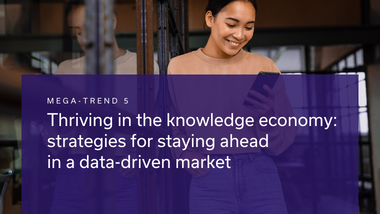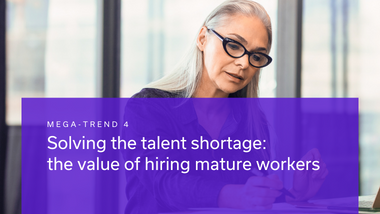8 strategies to consider for post-pandemic workforce management

Head of EMEA and US Sales, Pete Donaldson shares eight strategic ways to build the workforce required for the future. From a post-pandemic recovery to the uncertainty companies will face, a future-proof strategy to workforce planning is necessary for organisations to succeed in the short and long term.
As the COVID-19 crisis continues to take its toll – a big question many organisations are asking is how to prepare for the future. Post-pandemic, when the economy is roaring on the road to recovery, how are companies ensuring the right people with the right skills are in a place to help a business survive and thrive?
The case for Strategic Workforce Planning has accelerated in the face of digital transformation and the onset of the COVID-19 pandemic. As decades of science fiction come to fruition, businesses are now moving at a pace that demands agility and adaptability from its talent, otherwise the cost of running a lap behind could spell the end.
Yet, according to a McKinsey report, more than 90% of the UK workforce lack the skills they’ll need to do their job well in 2030 – that’s 30 million people who will require upskilling and/or retraining. This underscores the challenges the country is up against following COVID-19 and Brexit: Nine out of 10 employers are already admitting they’re struggling to recruit people with the skills they need.
To me, this means a few of things:
- We need to start looking at the work to be done and not the FTE worker.
- We need to engage with our people, map the skills they have and anticipate the skills they’ll need and create a roadmap to get there.
- We need to link business transformation to our people strategy (e.g., how an industry innovation might alter workforce need).
- We need to be agile in our planning to change course as we go.
So how do we do this?
- Build a Specialist Team
Employ a team that’s purely dedicated to workforce planning. The roles and objectives are complex and requires you to account for it as a cost, but it will save your organisation significantly in the long run as they help determine how you can “build, buy, borrow or bridge” to build functional organisational strength.
- Make the Future Known
Engage the business and take everyone within the organisation on this journey. From board to managers to junior staff – it’s integral that your people are invested in the future and visualise what they are working towards.
- Work before Worker
The rise and adoption of a contingent workforce is gaining traction rapidly. From remote working spurred by COVID-19 and Brexit, companies are looking to alleviate fixed costs and I’m starting to see the traditional role of the FTE is become undone. My clients have been sharing their qualms with systems and approvals for one FTE, yet I’m seeing work would require at least 3 people on different arrangements (part time, gig or contract worker) to complete. Unfortunately, most organisations continue to operate within archaic HR systems that don’t allow for different arrangements of contingent workers to neatly fit in – companies need to further develop agile methods of working and rethink the traditional FTE role and responsibilities.
- Audit Your Existing Workforce
It’s important to visualise who within your organisation has what skills, what their adaptability is to change and whether they’d be a good match for future skills with current and additional prospective training. Reskilling is noted to boost productivity by 12%, and beyond the benefits of not having to pay a premium for niche skills, organisations who understand the potential and reward of reskilling and upskilling are the organisations that succeed.
- Determine the Future Skills Needs of the Business
We might not have a crystal ball, but you can make astute guesses to the core skills required in the future to shape successful workforce planning. At Resource Solutions, we regularly report on market data and highest job rises (emerging skills) such as data analytics (+106%), user stories (33%), scrum methodology (+15%) as well as agile and waterfall (+29%) approaches to development, knowing how to use Jira (+25%), UX concepts (+23%) and product ownership (+17%). These insights are available from your recruitment provider.
- Engage Learning & Development
With a skills directory in hand for your business and an idea of what is needed to empower your organisation’s future, you can now engage L&D and training providers to upskill or reskill your workforce. A company that is doing this this particularly well is www.infinityglobal.io and is the partner of choice for us.
- Internal Contingent Workers
When we talk about contingent workers, we often look externally. What if we thought of the potential of ‘internal gigs’ where we’re able to redeploy workers who are either looking to upskill or have the capability and capacity to work short term on internal projects? We’ve seen numerous occasions of this happening throughout the COVID-19 pandemic, and in my view, it’s a trend that smart companies are accelerating and activating. At the end of the day, it’s about the work – can it be done most effectively and cost-efficiently with an external consultant or an internal FTE?
- Fail Fast & Fail Forward
Finally – organisations have to be agile. Be prepared to try new thinking, encourage innovation and fail fast and fail forward. The world is changing faster every day as are its workforce dynamics. The future of work requires new thinking – you will make mistakes – but ultimately, you’ll always be ahead of those that don’t try.
There are certainly a lot of unanswered questions, but the one area I am sure on is that we will need to understand the needs of our businesses better linking the people plan more closely to business transformation and the companies that are able to balance work before worker, maximising internal to external delivery and gaining total skills visibility will be those that ultimately win in the war for talent.











